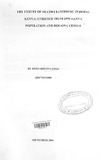| dc.description.abstract | This study set out to explore the extent of concentration of infant and child deaths in rural
Kenya, as well as to investigate the factors that influence such clustering of deaths. It
also hoped to come up with.' findings and recommendations th~would guide future
programme planning and to influence policy on issues regarding child survival
programmes.
As a point of departure, the study was guided by two main research questions; is there
evidence of death clustering in rural parts of Kenya? What are the factors that influence
the concentration of such infant and child deaths?
To be able to adequately address the above issues, I adopted a modified version of
Mahadevan (1986) model of studying child survival. The adoption of this model and not
the others popularly used in mortality studies e.g Mosley and Chen (1984), was premised
upon two arguments. One is because the Mahadevan model unlike the Mosley and Chen
one, has concepts and terminologies that are specifically related to mortality. This is
important as it avoids the confusion that arises when using the term "intermediate" and
"proximate" determinants, which are more related to fertility. Instead, Mahadevan has
developed the terms "Life Affecting variables" and "imminent variables" to specifically
refer to mortality determinants. Secondly, the Mahadevan model is flexible and enjoys a
number of advantages that made it even more appropriate for this study. It incorporates
both micro and macro variables whose influence on the health and consequent death of
the child is diverse.
Again the model clearly recognizes the fact that several LAV's (Life Affecting Variables)
either in similar or dissimilar manner influence mortality in any society. It is this element
of dissimilarity that made the model more appropriate for this study.
Following the Mahadevan model (modified), two mam conceptual hypotheses were
operationalized. These were that; environmental factors were likely to act via imminent
variables to influence the risk of childhood deaths; and two, that child survival in Kenya
is likely to be influenced by socio-cultural and socio-economic factors.
During analysis to establish whether death clustering actually exists in rural Kenya, the
study compared two maternal demographic characteristics i.e parity and age, as well as
other characteristics i.e educational level attained and region of residence, with a
theoretical statistical distribution i.e binomial. The purpose was mainly to assess the
extent of differences in the variability among women and how these differences
contributes to the observed child deaths after allowing for chance factors (Zaba and ,
David, 1996).
Besides confirming the study hypotheses and answering the study objectives fully, the
results also confirmed earlier findings of studies of a similar nature by other scholars
(Khasakhala A. 1998; UNICEF 1998; Katende, J. 1983).
A number of studies have shown that deaths, particularly infant and child deaths have a
tendency to cluster or concentrate on certain women who share particular
characteristics. These characteristics are but conditions which may range from Socioeconomic,
socio-cultural, and environmental to demographic factors which determine the
direction of magnitude such clustering may take (Das Gunpta, 1990; Khasakhala 1993;
I McMurray 1997).
This study has demonstrated that there is overwhelming evidence of death clustering
among women in rural Kenya. This phenomenon is more pronounced among mothers of
higher parity, and older ages (i.e 30 years and above).
Secondly, the results have further indicated an over dispersion of the distribution of
deaths between women in parity groups. The analyses have further shown that there is a
true increase in risk concentration (and risk variability) among women at the highest
parities within each age group - a real indication of death clustering. | en |

